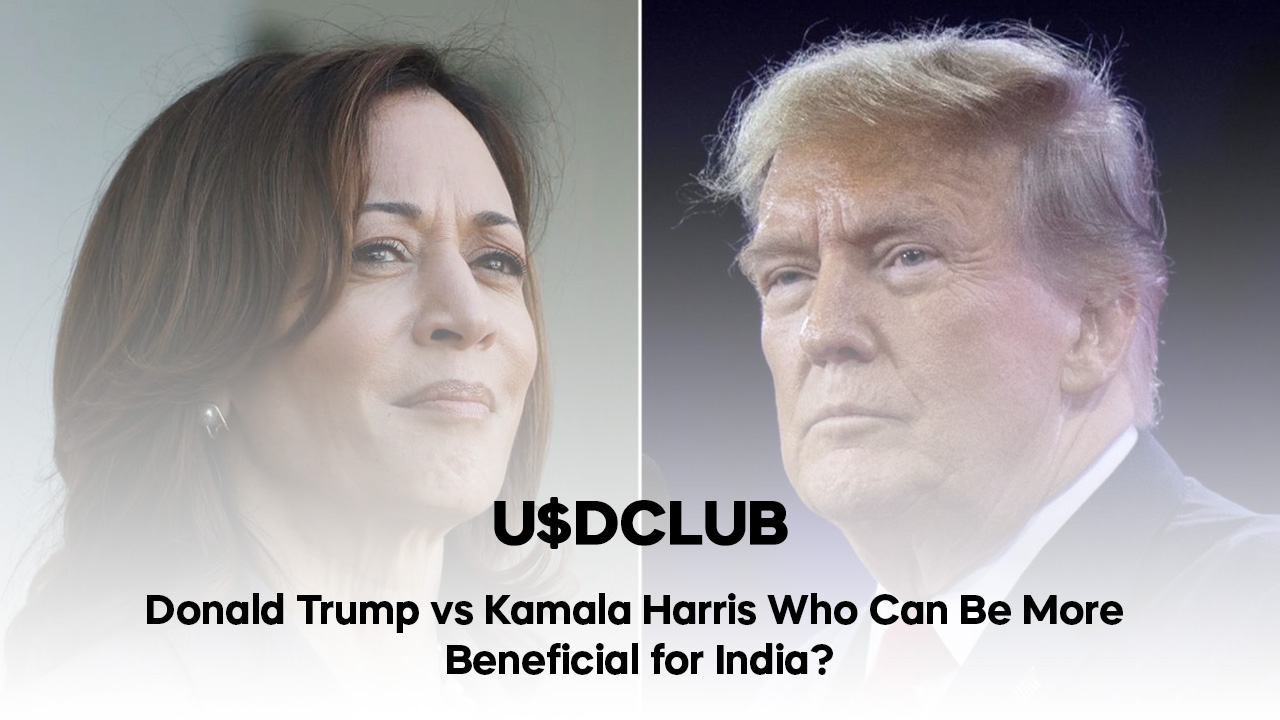The relationship between the United States and India has always been a critical part of international diplomacy, especially when it comes to trade, defense, and global security. The U.S. presidency plays a major role in shaping the foreign policy approach toward India, and the two prominent figures in American politics—*Donald Trump* and *Kamala Harris*—represent very different views on how they would approach relations with India.
Both Trump and Harris have unique backgrounds, policy priorities, and historical interactions with India. The question arises: *Which of Donald Trump or Kamala Harris could be more beneficial for India?* Let’s explore the policies, actions, and potential future impacts both leaders might have on India.
Donald Trump’s Impact on India: A Mixed Bag
-
trengthening Defense Ties
One of Donald Trump’s significant achievements in his relationship with India was the improvement of *defense cooperation* between the two countries. During his tenure, the United States and India signed numerous defense deals aimed at increasing military capabilities. For example, India purchased advanced weaponry and defense systems like *Apache helicopters* and *MH-60 Romeo helicopters*, bolstering India’s defense infrastructure.
Trump’s administration also furthered the *U.S.-India strategic partnership, with both countries collaborating closely on security concerns in the Indo-Pacific region. This was particularly relevant with the rising threat from China, making the U.S.-India defense ties crucial for regional stability. The Trump administration also supported India in countering China’s aggression in the **Ladakh border dispute* and endorsed India’s stance on safeguarding its borders.
-
Challenges in Trade Relations
Despite the growth in defense cooperation, Trump’s tenure was marked by *trade tensions* between the U.S. and India. His administration imposed tariffs on several Indian goods, which created friction in the bilateral trade relationship. These tariffs targeted Indian exports like *steel and aluminum*, among others, which led to retaliatory measures from India.
In addition, Trump removed *India from the Generalized System of Preferences (GSP)*, a preferential trade program that allowed Indian goods to enter the U.S. market duty-free. The loss of GSP privileges impacted Indian exporters, particularly in industries like textiles and leather goods, creating challenges for India’s trade balance with the U.S.
-
Immigration and the Indian Diaspora
Donald Trump’s stance on immigration has been a contentious issue. He adopted a tough approach, calling for stricter *immigration controls* and referring to many immigrants as “thieves” and “criminals.” This rhetoric, combined with his administration’s policies, raised concerns for Indians living in the U.S., especially those residing illegally. Many feared *deportation* or *limited pathways to legal status*, and Trump’s policies on work visas, particularly H-1B visas, became a cause for worry among Indian professionals working in the U.S. tech industry.
However, Trump did support legal immigration systems like the *merit-based visa program, which many qualified Indian immigrants could benefit from. His administration also worked to streamline the **green card process* for high-skilled workers, many of whom are from India.
-
Foreign Policy and Indo-U.S. Relations
On the foreign policy front, Trump viewed *India as a key ally* in countering China’s influence in the Indo-Pacific region. His administration placed India at the heart of its *“Free and Open Indo-Pacific” strategy, promoting a vision of collaboration between India, Japan, Australia, and the U.S. (commonly referred to as the **Quad* alliance). This cooperation was meant to counterbalance China’s growing assertiveness in the region, which aligned with India’s own strategic interests.
However, Trump’s *America First* policy also raised concerns in India, as it often prioritized U.S. interests at the expense of global partnerships. His administration was known for withdrawing from multilateral agreements, which occasionally created tensions in international relations, including with India.
Kamala Harris: A More India-Friendly Approach?
-
Indian Heritage and Personal Connection to India
Kamala Harris’s Indian background is a key factor when considering her potential approach to India. Born to an Indian mother from Tamil Nadu, Harris has spoken publicly about her *Indian heritage* and the influence her mother had on her life. Many Indians view Harris’s background as a reason for optimism, believing that she might have a better understanding of India’s culture and challenges than previous U.S. leaders.
Harris has acknowledged *India’s importance as a strategic partner, and her administration would likely prioritize stronger ties in areas like **climate change, **global security, and **economic cooperation*. Her deep connection to India could also create more goodwill between the two countries, as she would bring an informed and personal perspective to U.S.-India relations.
-
Immigration Policies: A Boon for Indians?
Harris’s immigration policies could be beneficial for India, especially when compared to Donald Trump’s restrictive stance. Harris has advocated for *more humane immigration policies, with a focus on providing pathways to citizenship for undocumented immigrants and reforming the H-1B visa program. For Indian immigrants and the **Indian tech workforce, this could mean easier access to **work visas, **green cards, and **citizenship* opportunities.
Harris has also been a strong advocate for *family-based immigration* and reducing the backlog for green cards, a move that would benefit thousands of Indian families waiting for years to obtain permanent residency in the U.S.
-
Trade and Economic Relations
Under a potential Kamala Harris administration, *trade relations between the U.S. and India could see a revival*. Harris has indicated her interest in reducing trade barriers and increasing bilateral trade partnerships. This would address some of the concerns raised during Trump’s tenure when tariffs on Indian goods became a point of contention.
India could benefit from a more *balanced trade policy, as Harris is likely to support more open markets and fair trade practices. This could restore India’s **GSP status* and pave the way for improved economic ties between the two countries.
-
Criticism of India on Human Rights Issues
However, Kamala Harris’s relationship with India has not been without controversy. She has been a vocal critic of *India’s actions in Kashmir, particularly after the **revocation of Article 370* in 2019. Harris has spoken out against what she perceives as human rights violations in Kashmir, and this could create friction between the U.S. and India on sensitive issues.
Her criticism of India’s internal policies could strain diplomatic ties, especially if her administration takes a strong stance on *human rights* and *freedom of speech* in India. However, this could also provide an opportunity for constructive dialogue on these issues, leading to reforms that align with global democratic standards.
Comparing Trump and Harris: Who is Better for India?
Donald Trump’s Pros:
– *Strong defense ties* with India.
– Support for *countering China’s influence* in the Indo-Pacific region.
– Advocated for *merit-based immigration*, which could benefit skilled Indian workers.
Donald Trump’s Cons:
– *Trade tensions* due to tariffs and removal of GSP privileges.
– Harsh *immigration policies* that negatively affected Indian immigrants, especially those on H-1B visas.
– Focused more on *America First*, sometimes at the expense of international alliances.
Kamala Harris’s Pros:
– Strong *cultural and personal ties* to India.
– More lenient and *humane immigration policies* that could benefit Indian immigrants.
– Likely to promote *better trade relations* by reducing tariffs and encouraging open markets.
Kamala Harris’s Cons:
– Criticism of India’s policies on *Kashmir* could create diplomatic tension.
– May prioritize *human rights issues*, which could strain bilateral relations in sensitive areas.
Conclusion: Who Is More Beneficial for India?
When comparing Donald Trump and Kamala Harris, both have potential advantages and challenges for India. While *Donald Trump* provided strong defense support and strategic alignment against China, his *trade policies* and tough stance on *immigration* created challenges. On the other hand, *Kamala Harris, with her **Indian heritage* and progressive policies on *immigration* and *trade, could open new doors for India, but her criticism of **India’s internal policies* could create diplomatic strains.
Ultimately, the leader more beneficial to India will depend on the priorities of the Indian government and what aspects—whether it’s defense, trade, immigration, or diplomacy—are most critical to the relationship. For now, both offer different pathways to strengthening U.S.-India relations, but each comes with its unique opportunities and risks. As always, investors must stay informed about both global and domestic events that influence the stock market. For more updates on market developments, IPOs, and investment insights, stay tuned to USDCLUB.US







